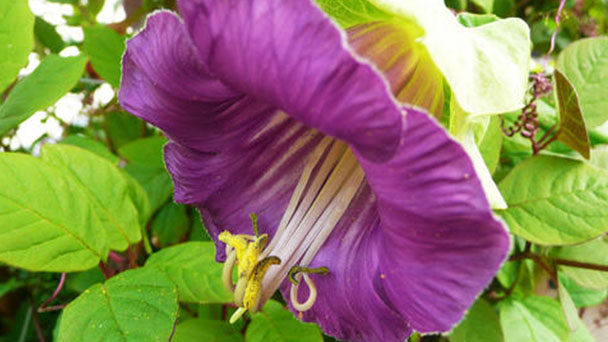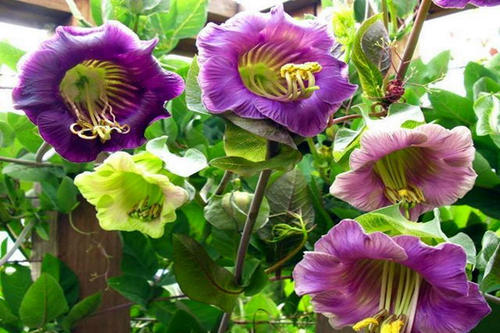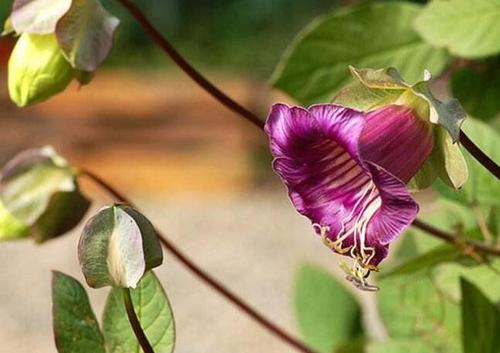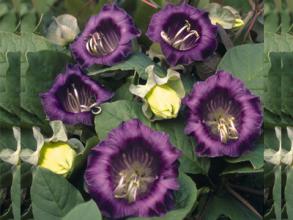Cup and Saucer Vine (Cobaea Scandens) Profile
Written by admin
Sep 18 2021

Cup and Saucer Vine (Cobaea scandens Cav.) is a perennial twining herb, glabrous throughout. Cup and Saucer Vine leaflets are 3 pairs, elliptic or oblong, 6-9 cm long and 3.5-4 cm wide, petioles ca. 1 cm long, the lowest pair close to the stem, more or less auriculate or halberate, stipule like, tendrils branched; Calyx lobes is broad, suborbicular, mucronate; Corolla ca. is 5 cm long, campanulate, greenish purple gradually turning purple. Capsule is about 4 cm long. Seeds of Cup and Saucer Vine are about 0.8 cm wide, thin and flat.
Cup and Saucer Vine is native to Mexico. Cultivated in the south, northwest and Guangdong province of China.
Cup and Saucer Vine picture

Cup and Saucer Vine info
| Botanical Name | Cobaea scandens |
| Common Names | cup and saucer vine, cathedral bells, Mexican ivy, or monastery bells |
| Plant Type | Flowering vine |
| Light | Full sun |
| Water | Well-drained soil |
| Mature Size | 10–20 ft. long, 3–6 ft. wide |
| Flower color | Green, maturing to purple |
| USDA Zones | 9 to 11 |
Cup and Saucer Vine Morphological Characteristics
Cup and Saucer Vine is a perennial twining herb native to tropical America. These lianas grow up to 20 feet (6 meters) tall there and have large bell-shaped flowers that are purple or yellow-green in color. cup and saucer vine Each leaf of the genus Cup and Saucer Vine consists of a cluster of small leaves on either side of the main stem, each topped by a tendril, which is used for climbing. Flowers are fragrant, bell-shaped, 5 cm long, creamy green, turning purple as they age, leaves divided into 4 narrow to ovate branches, dark green.
Cup and Saucer Vine Distribution
Cup and Saucer Vine distribution abroad: native to forests or shrubs in Mexico.
Domestic distribution: China's southern Yunnan, northwest and guangdong province are cultivated.

How to Grow and Care for Cup and Saucer Vine
Flower pot
There are some things to be careful about when choosing a Cup and Saucer Vine on a flower pot. First of all, you can choose ordinary medium-sized flower pot Cup and Saucer Vine. Of course, this kind of flower pot Cup and Saucer Vine, when the pot is burst, the branches will grow to the ground, affecting the ornamental quality. Cup and Saucer Vinee is best to choose a hanging basin, hanging it on the wall above, after bursting the basin is very ornamental.
Water
In the spring and autumn growing season, the number of times of watering Cup and Saucer Vine needs to be increased. Water every 2 to 3 days is enough, and every watering must be watered thoroughly, so as not to form water and cause rot. During the summer dormant period to reduce the number of watering, winter to prevent frostbite, we also need to reduce watering.
Fertilization
Cup and Saucer Vine (Cobaea scandens) is a plant that doesn't need much fertilizer, but when it's growing season, it can be used every other month to help it grow. We had better be to apply the liquid fertilizer of lower concentration, lest appear fertilizer harm!
Soil
Loose and breathable soil is suitable for Cup and Saucer Vine cultivation. Leaf-rotting soil, river sand and garden soil can be mixed as pot soil, and basic fertilizer can be added to it, and then exposed to the sun for disinfection. Such soil has strong drainage and air permeability, and can also meet the needs of Cup and Saucer Vine for a period of time. Basically, the soil does not need to be changed in 2 to 3 years.
Light
Adequate light can make Cup and Saucer Vine grow more healthily. If there is no light for a long time, the leaves of Cup and Saucer Vine will appear dry-brown, and the color of the leaves will turn white.Therefore, keeping the light of the lover's tears can make the leaves of Cup and Saucer Vine more plump and green, and enhance its ornamental value.
Temperature
The best growth range of Cup and Saucer Vine is between 18 ℃ and 35℃. It can be said that the higher the temperature, the faster Cup and Saucer Vine will grow. However, Cup and Saucer Vine is not cold resistant at all. If the temperature is lower than 15℃, the growth of money at night will slow down. If the temperature is lower than 10℃, it will stop growing.
Pruning
Cup and Saucer Vine is a climbing vine plant, so if Cup and Saucer Vine is properly maintained, it can basically burst the pot, and the branches will be very dense at this time. At this time, it is necessary to scour and remove diseased branches and inactive branches, so that the nutrition can be more concentrated on the strong branches.
How to Propagate Cup and Saucer Vine
In spring climate at 18℃, Cup and Saucer Vine can be sowing, and can also be softwood cuttings.
Cup and Saucer Vine Pests & Diseases
Cup and Saucer Vine can attract aphids, especially when the plants are young and succulent. Frequent blasts of water or a couple of treatments of insecticidal soap should control them. Older plants can also fall prey to spider mites, especially during dry weather.

Latest Updated
- Benefits of Bugleweed - 7 Science-backed Health Benefits
- Bugleweed Dangers & Side Effects - Is It Poisonous?
- How to Plant Evergreen Trees - What You Should Know
- When to Plant Evergreens - Grow Guide for Evergreen Trees
- 12 Wonderful Evergreen Shrubs for Your Garden
- 12 Popular Evergreen Plants with Pictures for Beginners
- When And How To Prune A Lilac Bush Like a Pro
- How to Grow & Care for Lilac Vine (Hardenbergia Violacea)
- Japanese Lilac Tree (Syringa Reticulata) Care & Propagation Guide
- Shumard Oak Pros and Cons - What to Know
Popular Articles
- Winter maintenance of Antirrhinum Majus
- How to Grow Terminalia Mantaly Tree
- How to Grow and Care for Crossostephium Chinense
- How to grow Antirrhinum Majus in spring
- Peristeria Elata (Dove Orchid) Profile: Info & Care Guide
- Underwatered Snake Plant (Sansevieria Trifasciata) - Signs And How To Fix
- How to Care for Brazilian Jasmine Plant (Mandevilla Sanderi)
- How to Grow & Care for Graptopetalum Purple Delight in Summer
- Rosa Chinensis (China Rose): Plant Growing & Care Tips
- How to Care for Baby Sun Rose (Aptenia Cordifolia)